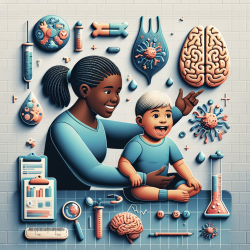Enhancing Practitioner Skills: Neurodevelopmental Outcomes in Children with Tuberculous Meningitis and Hydrocephalus

The clinical characteristics and neurodevelopmental outcomes of children with tuberculous meningitis (TBM) and hydrocephalus provide critical insights for practitioners. A recent study by Rohlwink et al. (2016) offers valuable data that can help enhance the skills of practitioners working with this vulnerable population. Here’s how the findings from this research can be implemented in practice.
Key Findings from the Study
The study examined 44 children treated for TBM with hydrocephalus. Key findings include:
- High Mortality and Morbidity: The mortality rate was 16%, with significant neurological and neurodevelopmental deficits in survivors.
- Neurodevelopmental Deficits: All children showed neurodevelopmental deficits compared to controls, particularly in locomotion, language, and executive functions.
- Impact of Infarcts: Multiple or large infarcts were strongly associated with poor outcomes.
Implementing Research Outcomes in Practice
Practitioners can leverage these findings to improve outcomes for children with TBM and hydrocephalus by focusing on the following areas:
Early Diagnosis and Treatment
Early diagnosis and prompt treatment are crucial. Practitioners should:
- Advocate for early and repeated cerebrospinal fluid (CSF) testing to improve diagnostic accuracy.
- Utilize imaging findings of basal enhancement and hydrocephalus to make a presumptive diagnosis and start treatment promptly.
Multidisciplinary Approach
A multidisciplinary approach can address the multifaceted needs of these children:
- Collaborate with neurosurgeons, infectious disease specialists, and rehabilitation therapists to manage the acute and long-term effects of TBM.
- Engage speech-language pathologists to address language and communication deficits early in the treatment process.
Focus on Neurodevelopmental Rehabilitation
Given the high prevalence of neurodevelopmental deficits, practitioners should:
- Implement individualized therapy plans that address specific deficits in locomotion, language, and executive functions.
- Incorporate family education and support to ensure a consistent therapeutic environment at home.
Encouraging Further Research
The study highlights the need for further research to improve diagnostic and treatment strategies:
- Investigate novel biomarkers or diagnostic tests for quicker and more accurate diagnosis.
- Explore therapeutic interventions that can mitigate the impact of cerebral infarcts on neurodevelopmental outcomes.
To read the original research paper, please follow this link:
Clinical characteristics and neurodevelopmental outcomes of children with tuberculous meningitis and hydrocephalus.
Citation: Rohlwink, U. K., Donald, K., Gavine, B., Padayachy, L., Wilmshurst, J. M., Fieggen, G. A., & Figaji, A. A. (2016). Clinical characteristics and neurodevelopmental outcomes of children with tuberculous meningitis and hydrocephalus. Developmental Medicine and Child Neurology, 58(5), 461-468. https://doi.org/10.1111/dmcn.13054










